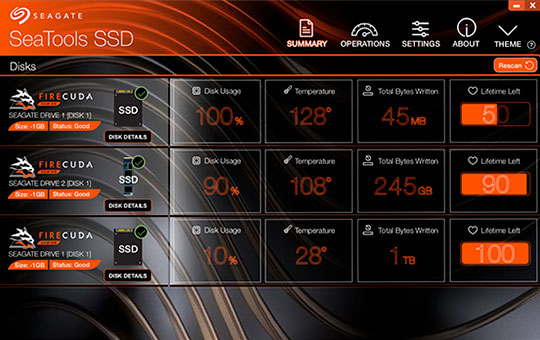
#Seagate seatools fix all fast software
Thus, if a SMART error appears suddenly, it virtually always means, unfortunately, that the drive is about to fail and should be replaced.Ī third-party SMART software issued an alert: SMART tests indicate whether a drive is approaching imminent failure. Please see our Warranty Information page for replacement information.Įach Seagate hard drive engages in regular self-tests, and most computers automatically run regular SMART tests on the hard drive(s) installed on them. Therefore, if SeaTools indicates that the drive is failing, Seagate recommends backing up your data immediately and replacing your drive. A drive may be failing but continue to function normally for a short time, so SeaTools is often a better judge of whether the hard drive is failing than the drive's functionality at any given moment. SeaTools' PASS or FAIL is the standard that Seagate uses to determine whether a hard drive is still in good working order or is failing. Under what circumstances did the SMART error occur?

If you cannot determine whether the drive is spinning: If you do not hear or feel the hard drive spinning, the drive did not start. If you touch the side of the drive you should feel a slight vibration. Check to see if the hard drive is spinning. This will stop any power saving commands from being sent. Open the computer case and remove the data cable from the hard drive.If the drive is not receiving power or receiving an incorrect level of power, it will not spin up. To check to see if this is the cause of the BIOS not detecting the hard drive, follow these steps: Note: These steps are NOT applicable for SSD drives. If you have received a SMART error, we strongly recommend that you stop everything and make an immediate backup of any and all important data contained on this drive that is not already backed up. If a "SMART error" has recently appeared on your computer, this generally means drive failure is imminent or has already occurred. One error in particular, however, is more important than others to watch out for. This set of troubleshooting steps will attempt to get the drive detected again, or to conclude whether the drive has failed and should be replaced.

Instead, some error message will occur, and it will become obvious that a serious problem has occurred. So, if the computer suddenly stops detecting the bootable drive, this will almost certainly mean that the computer will fail to boot at all. It is the source of most of the computer's operations. Generally, if a SATA drive is configured as the bootable drive, then the computer relies on that drive to boot the computer and to launch Windows.


 0 kommentar(er)
0 kommentar(er)
